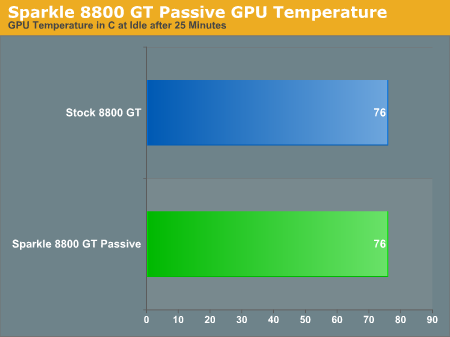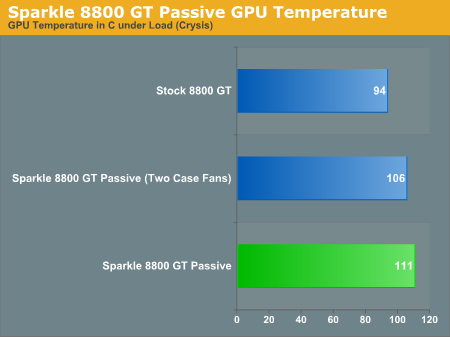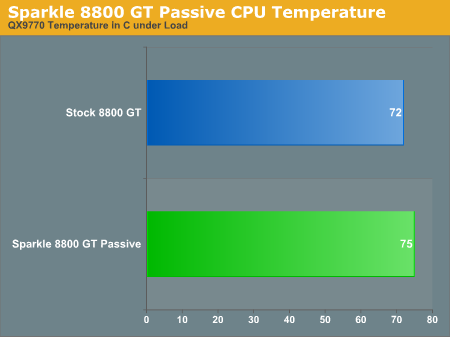Sparkle 8800 GT Passive: The Fastest Silent GPU in the World
by Anand Lal Shimpi on November 29, 2007 12:00 AM EST- Posted in
- GPUs
Once again, Crysis was our benchmark of choice as it seems to put the greatest stress on GPUs. We played for hours on end until the GPU temperature leveled off, using nTune to monitor temperature levels from the GPU's on-die thermal diode. Note that playing Crysis actually got these GPUs hotter than looping the 3DMark '06 HDR/SM3 tests, although only by 1 - 2C.

Interestingly enough, at idle, both the stock 8800 GT with its fan and the Sparkle passive card reach about 76C. The only explanation is that the 8800 GT's fan is designed to remain as quiet as possible, so it doesn't actually do all that much cooling when the GPU isn't being stressed.

Running Crysis, the stock 8800 GT's GPU peaks at around 94C with the two 80mm case fans in the system unplugged. The passively cooled Sparkle in the same situation is already at 111C, an increase of 17C, not nearly as much as we honestly expected but still quite hot.
Turning the case fans on drops the GPU temperature to 106C, showing that airflow in the chassis is important.

The impact on CPU temperature was actually marginal, the hottest of the four cores of the QX9770 only saw a 3C increase in core temperature.
Despite our best efforts, the Sparkle 8800 GT Passive prevailed, although posting some worryingly high GPU temperatures the card never crashed during our tests.










55 Comments
View All Comments
toyota - Thursday, November 29, 2007 - link
We don't know how the 256MB variants will perform, but NVIDIA claims that they will arrive at $179 - $199.http://www.anandtech.com/video/showdoc.aspx?i=3151...">http://www.anandtech.com/video/showdoc.aspx?i=3151...
jonnyGURU - Friday, November 30, 2007 - link
Yeah. Comparing an XFX card at TigerDirect vs. a BFG card sold at it's MSRP on the manufacturer's webstore is very subjective journalism there Anandy. ;)Tegeril - Monday, December 10, 2007 - link
It would seem that you missed the part where those prices were shown to highlight shipping costs.toyota - Thursday, November 29, 2007 - link
no edit?also the same article says this about 8800gt 512mb: Prices went from the expected $199 - $249 to a completely unexpected $250 - $300 range.
Crusader - Thursday, November 29, 2007 - link
Looks just like my 8600GTS from MSI with passive cooling.Gonna have to upgrade to this card though!
docmilo - Thursday, November 29, 2007 - link
I just gutted my tower and stuck my computer into a Q-Pack case and my x1900xt is running over degrees cooler. The power supply in the small case blows a ton of air straight down on the video card and when I run the ATI overdrive my card never gets over 80 degrees when testing for a stable overclock where it would push 100 degrees in my full tower case.This thing would be perfect for a case like mine.
docmilo - Thursday, November 29, 2007 - link
Over 10 degrees cooler that is. Where's the edit button when you need one?kilkennycat - Thursday, November 29, 2007 - link
Ah, yes. After at least 2 years, Anandtech and Dailytech still have not been able to attain the edit-sophistication of the article-comment section of "The Tech Report" . Maybe Scott and his crew could give the Anandtech/Dailytech web-designers a hint or two ?gerf - Saturday, December 1, 2007 - link
Editing is lame. Post it for better or for worse. I even frequent forums with no editing, much like this, and prefer it over the crappy phpBB forums.Basilisk - Thursday, November 29, 2007 - link
Perhaps I misunderstand your post, but... putting this card in my X-Qpack case would require removing a large portion of the power-supply (over the video card slot) where the heat pipes need to pass over the card. Same problem with several other cases I've used.Which is the @#$%^ problem with most passively cooled powerful GPU's: their pipes increase the vertical requirements too much. I wish they'd either notch the top of the cards for the pipes, or pass the pipes through notches on either end of the card. The current "over the top" approach minimizes their effort in re-utilizing non-passive card layouts, but the reverse could be done -- just build all cards on the notched-board design even if they use fans and no pipes.